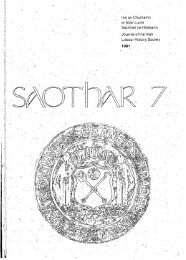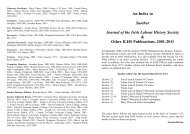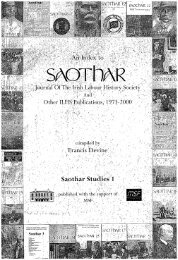102 SAOTHAR13statistical forms. Regular features include notes on Congress activities; copies of Congress statementsand submissions; summaries of official reports and legislation; Labour Court, Rights Commissioner,Employment Appeals Tribunal and Equality Officer recommendations and determinations; and wagemovements, consumer price indeces, unemployment figures at national and sectoral levels anddemographic data. All this information covered trade union concerns in both the Republic and NorthernIreland.The value of some journals stretches beyond the union itself. The Postal Worker and Civil Servantare important not only for the history of the Post Office Workers' Union and the Civil Service ClericalAssociation but for public service organisations generally. Major concerns for. these bodies from theearly 1920s to the early 1950s include the cost of living bonus, the Stabilisation of the Cost of LivingBonus Order, 1940, and the fight for the establishment of an independent conciliation and arbitrationsystem. Both journals give extensive details on these issues.General workers are, perhaps, not so well served by journals. The Irish Union of DistributiveWorkers' and Clerks (IUDWC) was the only union consistently to issue a journal. The Irish Transportand General Workers' Union (lTGWU) issued Liberty 'from 1949 on and had, of course, beenassociated with the Irish Worker, Watchword anda number of other titles at an earlier time,! and theWorkers' Union of Ireland issued Report between 1952-54 and later Bulletin from 1957-65. Themonthly issue of the Distributive Worker remains, however, the most consistently valuable source.Annual delegate meetings, branch meetings and, up to 1934, details of the union's national healthinsurance section featured in the journal. 2 The annual reports of the general secretary are supplementedby branch secretaries' annual reports. There is important information relating to the organisation ofparticular categories of workers such as tailors, garment and clothing workers in the 1920s and lawclerks and typists in the early 1940s. Law clerks and typists proved hard to organise as, despite apublicity campaign only 13% out of a potential membership of 700 had been organised by the end of1943. 3The Distributive Worker covers issues such as the minimum wage question, the Shop Acts, closinghours/orders, apprenticeship and legal cases such as the Enniscorthy picketing case. From at least 1934the IUDWC was involved in legal cases concerning the right to picket in trade disputes. 4 'Branch Notes'cover disputes and strikes ranging from a lock out of members in Ballaghadereen, 1925,5 to a disputeover the question of minimum wages in the Belfast Damask and Linen Company, Dublin, which lastedover eight and a half years before ending in 1945. That strike was one that th~journal claimed 'wouldgo down in history as one of the most protracted in the whole history of trades unionism'.6In common with other unions, the lUDWC' s principal activity in the early 1940s was the negotiationof standard wage orders, bonus orders and additional bonus orders under the terms of EmergencyPowers (No. 166) Order and its various amendments, (1942!3V Copies of wage rates and bonus ordersachieved are usually printed in the journal; later, this practice continued with Labour Court WageOrders, National Wage Agreements and copies of other negotiated agreements. s Branch reports werea regular feature with the Dublin ones being particularly comprehensive. Both R.M. Fox and HannaSheehy-Skeffington were regular contributors as the journal carried articles of general interest, shortstories and other literary works.Some information given in union journals should be treated cautiously. Obviously the organisationalinterests of the union will dominate "at times and consideration should be given to inter-unionrelations, particularly for unions operating in a competitive fashion within the same industry or workarea. The Postal Worker was extremely critical of the Association of Irish Post Office Clerks, formerlythe Dublin Civil Service Telegraph Association, in the 1930s and later of another breakaway from thePost Office Workers' Union organising indoor workers, the Post Office Clerical Association, thejournal seldom mentioning the association's name but using the term 'secessionists' instead. Similarly,the Distributive Worker was occasionally critical of the Irish National Union of Vintners, Grocers' andAllied Trades' Assistants and of the Irish Commercial T~avellers' Federation, which for a short period,1936-44, was amalgamated with the lUDWC.9 Sometimes different unions, in their separate journals,
SOURCES 103would claim credit for the same achievement. Thus the ITGWU in Liberty stated that it was they ratherthan the Irish Women Workers' Union who fIrst achieved the principle of two weeks holidays withpay.10 More modestly, the Postal Worker stated that' among civil service organisations the union holdsa place of honour and it has ever been in the vanguard of every fight to improve the conditions of civilservants'. 11 / .;' .. • -' ,An employers' perspective, some would argue already well represented in the press, can also'.befound in the relevant trade journal and these should be consulted, where available, to complementresearch based on trade union journals. 12 B ut trade union journals are often the only source giving aunion viewpoint on a particular subject, are readily accessible, are important supplements to survivingrecords and, sadly, in many cases comprise the most significant or only record source for the union.When the Irish Labour History Society Trade Union and Labour Related Records Survey guide ispublished, researchers will have available an accurate list of what trade union journals survive andwhere they may be consuItedP The National Library ofIreland already has many journals available,some on microfilm. The general catalogue will indicate precise reference for periodicals but a shorterguide is available for consultation at the counter for those journals classifIed as newspapers, A guideto the trade union journals in the National Library is reproduced here. Many unions have neverdeposited their journals with the NU and in such cases access can only be achieved by direct applicationto the unions concerned.NotesSarah Ward-Perk ins1. For details of rrowu journals held by the union itself, see Mary Carolan, 'Expanding Trade Unionism: therrowu Library', Saothar 11,1986, pp. 101-4.2. The Health Insurance Act, 1933, revolutionised the whole system of health insurance in Ireland providing thatthe.existing sixty five approved societies would gradually be absorbed into a unified society. The IUDWCsociety was transferred to the Unified Society on 30 June, 1934. See Distributive Worker, xii, 1933, p. 81;xii, 1934, pp. 115-6, 136-9.3. ibid., xxiii, 1944, pp. 34-5.4. The decisions in these cases 'were of great importance, establishing ... the right conceded in the Trade DisputesAct, 1906 of workers to assemble near the premises in which the dispute occurred for the purpose of receivingor conveying information that a trade dispute exists or is in contemplation', ibid., xiv, 1935, pp. 234-5; xiii,1934, pp. 219-221, 241-2:5. ibid., iv, 1925, pp. 185-6.6. ibid., xxv, i946, pp. 39-42,66-7.7. See, for example, ibid., xxiii, 1944, p. 3: xxv, 1946, p. 81.8. For example see Hours Agreement with Dublin Merchant Drapers' Association, ibid., x, 1931, pp. 161-2;Agreement with Wholesale Clothing and Cap Manufacturers, ibid., xiii, 1934, pp. 161-3; and BelfastNationalJoint Industrial Council for retail Drapery, Outfitting and Footwear Trades, ibid., xxiii, 1944, pp. 77-81.9. ibid., xxiii, 1944, pp. 42-3.' .10. Liberty, vo!. 1, no. 3, 1949, p. 4.11. Postal Worker, xxii, 1944, p. 56.12. Enda McKay, 'A Century ofIrish TradeJoumals, 1860-1960' in B. Hayley and E. McKay (eds.), 300 Yearsof Irish Periodicals, (Dublin, 1987), pp. 103-121.13. A Guide to DublinLabour Records, (forthcoming). The ILHS Survey has virtually completed the compilationof the guide and it is expected to be published late 1988, early 1989.
- Page 1 and 2:
JOURNAL OF THE IRISH LABOUR HISTORY
- Page 3 and 4:
ContentsPageEditorial: Labour Histo
- Page 5 and 6:
EDITORIAL 3freedom to participate i
- Page 7 and 8:
CorrespondenceThe Irish Labour Part
- Page 9 and 10:
; ~ ; ,The Decline and Fall of Donn
- Page 11 and 12:
THE DECLINE AND FALL OF DONNYBROOK
- Page 13 and 14:
THE DECLINE AND FALL OF DONNYBROOK
- Page 15 and 16:
·' THE DECLINE AND FALL OF DONNYBR
- Page 17 and 18:
THE DECLINE AND FALL OF DONNYBROOK
- Page 19 and 20:
THE DECLINE AND FALL OF DONNYBROOK
- Page 21 and 22:
THE DECLINE AND FALL OF DONNYBROOK
- Page 23 and 24:
THE DECLINE AND FALL OF DONNYBROOK
- Page 25 and 26:
,'-,;-''''.A PASSAGE TO BRITAIN 23C
- Page 27 and 28:
A PASSAGE TO BRITAIN 25only in the
- Page 29 and 30:
A PASSAGE TO BRITAIN 27clothing._De
- Page 31 and 32:
A PASSAGE TO BRITAIN 29established
- Page 33 and 34:
;:-.",.- .. .", ...... '.:. '
- Page 35 and 36:
LOUIE BENNETI 33feminist movement w
- Page 37 and 38:
:... ~: ."
- Page 39 and 40:
-.- '.LOUlE BENNETT 37While there i
- Page 41 and 42:
LOUIE ~ENNEIT 39Xl's encyclical Qua
- Page 43 and 44:
LOUIE BENNEIT 41Bennett's own relat
- Page 45 and 46:
LODIE BENNETT 43109; IWWU resolutio
- Page 47 and 48:
Essays in ReviewCosherers, Wanderer
- Page 49 and 50:
••• .".'. >. '~"ESSA YS IN RE
- Page 51 and 52:
ESSAYS IN REVIEW 49ConnolIy:Myth an
- Page 53 and 54: ESSAYS IN ~EVIEW 51tion' in the Int
- Page 55 and 56: ESSAYS IN REVIEW53International:'I
- Page 57 and 58: REVIEWScontroversy is real history.
- Page 59 and 60: REVIEWSJoe Monks was among the earl
- Page 61 and 62: REVIEWSnolly-Column Song','Proudly
- Page 63 and 64: REVIEWSresulting from the arrival o
- Page 65 and 66: REVIEWS,63the book by means of an a
- Page 67 and 68: REVIEWSlogue, it is hardly surprisi
- Page 69 and 70: The Team For All Workers ...CULIAIB
- Page 71 and 72: ESSAYS 69mission and moral refonn.l
- Page 73 and 74: .. ...... ~.~ -~ .'- '.ESSAYS. 71fr
- Page 75 and 76: ESSAYS 73claimed authority but whic
- Page 77 and 78: ESSAYS 75provided the basis for soc
- Page 79 and 80: ESSAYS 779. For comparisons see E.T
- Page 81 and 82: ESSAYS 7952. Annals of Christ Churc
- Page 83 and 84: ESSAYS' 81Fianna Fail and the Worki
- Page 85 and 86: ESSAYS 83Eireann in 1925 visibly di
- Page 87 and 88: ESSAYS 85recognition of the impract
- Page 89 and 90: ESSAYS 871970, it created the condi
- Page 91 and 92: ESSAYS89The Irish Immigrants' Contr
- Page 93 and 94: ESSAYS" 91Although anti -Catholic p
- Page 95 and 96: ESSAYS 93McCowie played a key role
- Page 97 and 98: :. -,,'.' ',. .~.,:.ESSAYS 95Althou
- Page 99 and 100: ESSAYS 97young girl of their own ba
- Page 101 and 102: SourcesIrish Labour History Society
- Page 103: SOURCES 101INovember, 1971 to no. 1
- Page 107 and 108: SOURCES105Sources for Irish Labour
- Page 109 and 110: SOURCES 107NorthWest Archives and L
- Page 111 and 112: SOURCES 109In 1966 the Finnish gove
- Page 113 and 114: TURNINGANEWLEAFThe CPSSUis the larg
- Page 115 and 116: REMINISCENCE 113us due to my politi
- Page 117 and 118: REMINISCENCE 115when Jim was presen
- Page 119 and 120: REMINISCENCE 117of Dail Eireann. 17
- Page 121 and 122: REMINISCENCE 119NotesThe above arti
- Page 123 and 124: DOCUMENT STUDY 121James Connolly in
- Page 125 and 126: DOCUMENT STUDY123SOCIAL DEMOCRATIC
- Page 127 and 128: DOCUMENT STUDY 125proletariat of th
- Page 129 and 130: DOCUMENT STUDY 127the support of Je
- Page 131 and 132: DOCUMENT STUDY 12926. The Workers'
- Page 133 and 134: 131BibliographyA Bibliography of Ir
- Page 135 and 136: BIBLIOGRAPHY 133Compton, P.A. Demog
- Page 137 and 138: BIBLIOGRAPHY 135Levine, I. and Madd
- Page 139 and 140: BIBLIOGRAPHY 137Turner, M. 'Towards
- Page 141 and 142: BIBLIOGRAPHY 1394. Land and Agricul
- Page 143 and 144: BIBLIOGRAPHY 141Clogher Record12 (2
- Page 145 and 146: BIBLIOGRAPHY 143Political Research
- Page 147 and 148: BIBLIOGRAPHY 145Pres, 1987.O'Brien,
- Page 149 and 150: 147Notes on Contributorsf onathanBe
- Page 151 and 152: 1901: Ireland's first general union
- Page 153 and 154: ELECTRICAL TRADES UNION .Establishe





